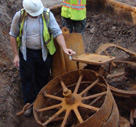 In the middle of Luminant’s Kosse Mine on a series of warm summer days, archeologists painstakingly uncovered the details of a late 19th– to early 20th-century community known as Headsville. The town had been small, its residents hardworking, its economic center a gristmill and cotton gin – pieces of which were just recently found partially buried within the southern part of the mine.
In the middle of Luminant’s Kosse Mine on a series of warm summer days, archeologists painstakingly uncovered the details of a late 19th– to early 20th-century community known as Headsville. The town had been small, its residents hardworking, its economic center a gristmill and cotton gin – pieces of which were just recently found partially buried within the southern part of the mine.
“We recognized we had an opportunity to discover more about the history of this area and felt the prudent thing to do was to bring in the right people to study it,” recalled Ricky Goodwin, director of mining operations at Kosse Mine.
Archeologists from Atkins North America were engaged to learn more about the site, which was initially found as crews surveyed the area for future mining. In July and August of 2010, Atkins pieced together details about the town and its place in local history and discovered the site was eligible for the National Register of Historic Places.
“They discovered that the gristmill, which is basically where the residents ground grain, provided an important service to the small community,” shared Goodwin. “Their report also showed how the addition of the cotton gin helped make Headsville a better place to raise a family. Unfortunately, because the local railroad bypassed the community, the town was unable to thrive.”
Atkins’ work on the project not only secured historical designation for the site, but it also garnered recognition from the Texas Historical Commission. The agency recently awarded the project the Texas Historical Commission Award of Merit for its work in preserving Texas cultural and historical resources.
“It was a good opportunity for us to work on this site because although we’ve done research on the Headsville community before, so little is known. Finding the cotton gin and gristmill and being able to do archival research gave us an opportunity to piece together a little more about the community,” said Meg Cruse, senior group manager of Atkins’ cultural resource division. “It was an exciting project, something we truly enjoyed doing and something a lot of people worked hard on.”
For more than 30 years, Luminant has contributed to the knowledge of Texas history through the sponsorship of archaeological investigations across the communities where the company operates. More than 1,200 archaeological sites have been recorded across all Luminant locations, and tens of thousands of artifacts have been recovered. In keeping with its commitment to protect the state’s cultural resources, Luminant makes every effort to carefully preserve and respect the rich Texas history that is part of its lands.
